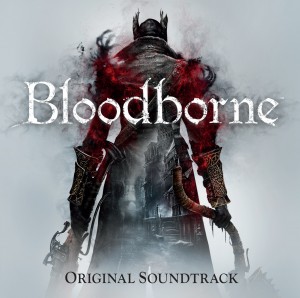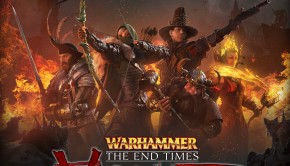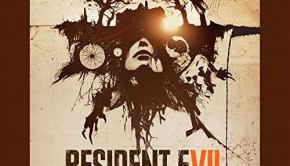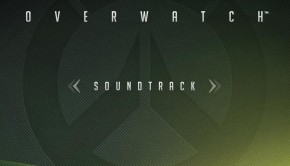Bloodborne Original Soundtrack
 |
Album Title: Bloodborne Original Soundtrack |
| Record Label: Sumthing Else Music Works |
|
| Catalog No.: N/A |
|
| Release Date: April 21, 2015 |
|
| Purchase: Buy at Amazon | Download at Sumthing |
Overview
Bloodborne‘s score is a haunting one, fitting for the dark, smoky world of Yharnam. Jointly composed by an international team, Ryan Amon, Tsukasa Saitoh, Yuka Kitamura, Cris Velasco, Michael Wandmacher, and Nobuyoshi Suzuki, the combination of composers is unusual, particularly given the fact that the length of the album itself rests just under 90 minutes. That said, score does its job extraordinarily well. I’ve always thought that darker games are more difficult to score, as it’s all too easy for composers to get caught up in creating the most morose or hair-raising batch of music without really giving it the necessary depth for a successful score. Bloodborne is extremely successful and not only avoiding this pitfall, but giving itself a musical identity that separates the title from other games in its genre.
The soundtrack was released in several forms: a two-disc, 25-track physical album by Team Entertainment in Japan; a digital edition of the same 25-tracks by Sony Computer Entertainment in the West; and a one-disc, 21-track physical and digital edition by Sumthing Else Music Works in the West. This review refers to the Sumthing Else release.
Body
The opening track, “Omen,” is a solid start to the score. Beginning on some impossibly low double bass strings, Amon uses a combination of a cello pattern, percussion, and the haunting vocal talents of Melissa Reese (who contributes to several other tracks on the album). The vocal line enters just after the halfway point of the piece in a mezzo-soprano range before leaping up to pure soprano notes. The melody is eerie and ghostly, but decisive — despite the chromatic steps taken by Reese, the powerful rhythmic accompaniment keep the piece from becoming too ethereal. However, just before the piece ends, the percussion and clockwork strings cease to exist, and the piece fades off into a disquieting silence.
“The Hunter” and “Cleric Beast” are two of the best action-oriented pieces on the score, the first written by Amon and the second by Saitoh. “The Hunter” has a question-and-answer melody in extremely low brass and strings. Often with darker games, when the music is particularly essential in establishing a horrifying or bleak mood, the score does not function well independently of the game; this is not the case for Bloodborne. “The Hunter” is pulse-pounding, exciting, and memorable, with choral shrills adding an extra chill to the piece as the melody degenerates into a powerful, octave-based motif, completely wild in affect. The transition from structured melody to out-of-control patterns is hard to pinpoint, but at no one point does the piece seem forced or artificial. “The Hunter” leads into “Cleric Beast,” a more structured while still dramatic track. The melody is extremely simple, following a diatonic scale. “Cleric Beast” begins with a slow, theatrical orchestra, bordering on a movie trailer piece in its intensity, and begins a subdivision about halfway through the track. The rhythm comes and goes while the slow choir returns momentarily in a series of hair-raisingly dissonant chords. The almost unbearable effect meshes really well with the returning rhythm — the two personalities of the piece seem to fit with each other. The track never settles, but neither does it fall into the trap of monotonality that particularly heavy scores sometimes fall into.
The album does have its fair share of quieter tracks. “Moonlit Melody” and “Lullaby for Mergo” are both more subdued, although they aren’t exactly peaceful — more like hypnotizing. “Moonlit Melody” is dark and eerie, thanks to Reese’s returning vocal talent, alongside some gentle echo ambiance and a sorrowful oboe solo. The melody is a variation of the one from “Omen,” but without the climatic rising and falling action. “Lullaby for Mergo” falls under the creepy music box trope, a popular inclusion in video game scores. Like “Moonlit Melody,” the piece may be softer but it is in no way calm — the music box is just out of tune enough and just chromatic enough to make the piece creepy, but not so much to make it sound entirely unpleasant. The plucked sounds are heavy, giving the impression of an extremely old or worn-out instrument, with the occasional unexpected use of chimes or bells around the chorus or repeated phrases.
When listening to the album I realized that out of the five composers, Ryan Amon did not only compose the majority of tracks, but he also composed most of my favorite tracks. The ones I kept returning to, like “The Hunter” and “Lullaby for Mergo,” just stuck in my head in ways that none of the other tracks did. However, I have to give credit to the compositional team for their coordination, which does not always find its way into group scores. In-house composer at FromSoftware, Yuka Kitamura, was another favorite. “Watchers” begins chaotically, but begins to take shape through its complex blend of male chorus and strings. The piece is incredibly rich, and Kitamura uses the already-established melodies in the score to build upon and generate a strong sense of consistency throughout the tracks. Another highlight of hers, “Ebrietas, Daughter of the Cosmos,” utilizes an even stronger choral section to generate a tone bordering on ecclesiastical and apocalyptic — it reminds me a little bit of the final destruction scene in Mordor from Howard Shore’s The Return of the King. The piece is powerful, relentless, and ploughs its way through the resounding chords slowly but without any hesitation.
One of the final tracks on the album is by Tsukasa Saitoh, another in-house composer at FromSoftware, called “The First Hunter”. I loved this piece from the minute I first heard it, and it’s one of those pieces that grows on me the more I listen to it. “The First Hunter” is a strings-heavy piece, but an eventful one. Saitoh, who also composed the afore-mentioned “Cleric Beast,” brings in a series of techniques and variations on rhythm and harmonies to ensure that the piece is dynamic enough for the listener. The melody is gorgeous. It was unquestionably the stand-out melody of the album to me, played on soprano violins over the alto cellos, and while it may have been more traditional than the majority of melodies in Bloodborne, it was unique in its unusual lack of chromaticism and darkness. The strings are eventually met by choir for a fuller sound, and the intensity of the music swells, and even when the track abruptly begins dropping octaves to fade off in the last thirty seconds of the piece, the emotion behind the track remains.
Summary
All in all, Bloodborne is an incredibly successful score, both achieving the effect that the game has upon its players while functioning beautifully as a stand-alone musical album. The quality of the tracks range from catchy to really truly memorable, but the album does not feel cheap at any point. Even the music box track, hardly an original concept, fits well with the murky world of Bloodborne, and is solidly executed. At times, the album can become overwhelming in its dreariness, but I was very impressed by how rarely that happened — certainly far less than I expected after seeing trailers for the game and noting its creation’s connection to the Dark Souls games. Unfortunately, the CD release of the score does not see some of the worthy contributions of Cris Velasco, but the remaining tracks still create a beautiful, gothic orchestral work fitting to accompany Bloodborne.
Do you agree with the review and score? Let us know in the comments below!
4.5
Posted on May 25, 2015 by Emily McMillan. Last modified on May 25, 2015.














